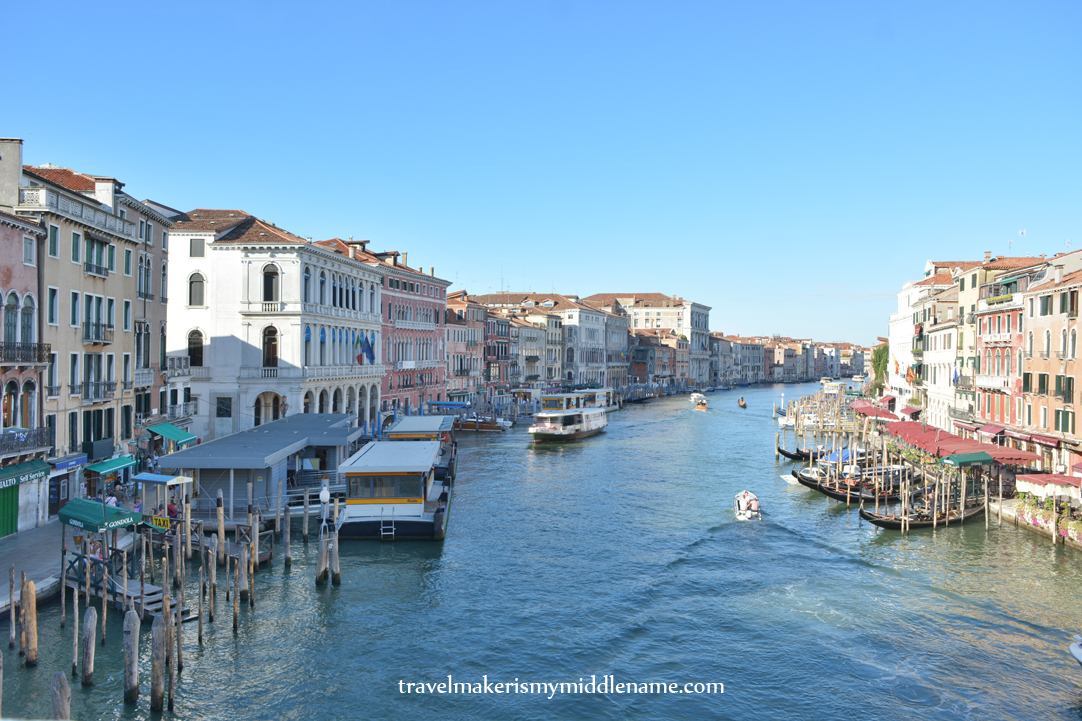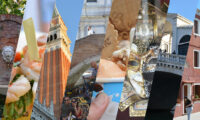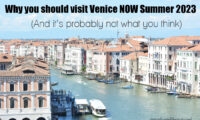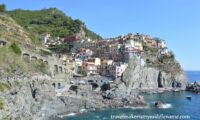Last Updated on: 27th April 2024, 12:48 am
Update: Venice has introduced a new entry fee on a 29-day trial to day visitors who do not stay overnight in Venice. Read more about it in the link at the top of the page.
This article provides a quick, informative guide on several aspects to Venice, Italy with just the essentials.
In this post:
- Where is Venice (a quick geography overview)
- What does Venice have to offer as a tourist destination
- How to get to Venice (detailed international arrival guide and transfers) (jump to public transport method)
- Why I don’t think the Alilaguna boat is worth it
- What to do in Venice
- The new visitor’s fee (trial phase) and how to avoid it
Where is Venice – location and geography
Venice is the capital city of the Veneto region in northern Italy and is located in the Adriatic Sea. The “Venice” of popular knowledge (the canals, gondolas, St Mark’s/San Marco’s Square, the Rialto bridge etc) is actually the attractions in the historical center of Venice which is made up of the small cluster of 100 islands and water canals located southwest of the mainland. It is where online maps such as Google Maps sometimes refer to as “Venice Metropolitan”.
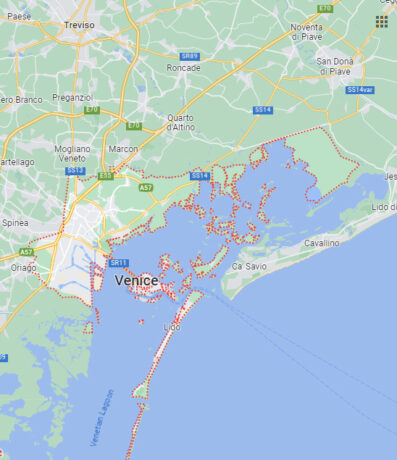
In reality, Venice city covers a much larger area than just the islands. The vast majority of Venice city (by land area) is in the mainland that is part of the rest of Italy, where there are cars and an international airport. Venice island on the other hand, is the historical center and is surrounded by the waters of the Adriatic Sea, which flows into the Venetian Lagoon and the canals, for which Venice is famous for.
What does Venice have to offer?
Venice is a well known historical town, famous for its canals, and is used as the base descriptor when describing similar towns in other countries. Venice has a history of almost 2,000 years, with European architecture made of Italian marble, and gondolas in the water.
Venice is an island so is surrounded by water, and is most famous for the canals and the traditional gondolas in them. These lie in the old historical town of Venice, away from the mainland. The island is made up of stone streets lined with historical and traditional stone buildings with ornate timber doors and shutters. Venice is also famous for San Marco (St Mark’s) square and the Basilica. There are also public squares and gardens and markets. Museums, shops, hotels and restaurants are housed in buildings are converted for modern use. The historical city is pedestrian-only – not even bicycles are allowed, although I did see one bicycle parked by the side of a building while there. Not that this does not mean you cannot drive to Venice, which in fact you can, you just cannot use a car to drive around within Venice once you get there.


Historical preservation and vehicle bans:
As already mentioned, in order to preserve the historical town, no vehicles of any kind are allowed in the islands, including bicycles. Thus the only way to get around in the historical town once you arrive, is by foot or boat of some sort. Even the ambulances within the islands are boat ambulances.
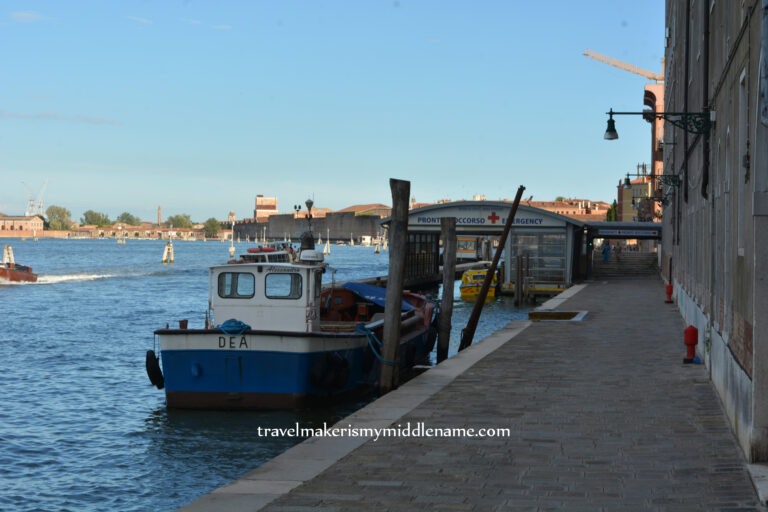
Note: Since no vehicles are allowed, you will be travelling everywhere on foot or by ferry so it is better to bring as little luggage as possible.
The stone streets traverse throughout the town and are connected with numerous small stone footbridges. Venice is well preserved historically from at least an aesthetics point of view. So, one of the key attractive aspects of Venice is the historical town of Venice islands and feeling the charm of the old town.
Small jetty boats are used to get around by private transport in the canal while “water buses” ie ferries (In Italian, “Vaporetto”s) provide public transport within the islands in open water, while gondolas, due to their narrow and hand powered nature, are only a popular tourist gimmick and priced accordingly as such and not used as a form of transport.
How to get to Venice
AIRPORT
Venice has its own international airport, two, in fact: Marco Polo International Airport and Treviso Airport.
Marco Polo International Airport (IATA code: VCE)
Official website: https://www.veneziaairport.it/en/
The main international airport of Venice is the Marco Polo International Airport (In Italian: Aeroporto di Venezia Marco Polo), and is located on the mainland, just under 14km from the islands. This is the one most people refer to when they talk about “Venice airport”. Transfer methods will be discussed below. See their official website for more information on transfers.
Note that sometimes Google maps may offer Treviso Airport (below) as “Venice Airport” if the person doing the search does not know they should be specifying Marco Polo airport.
Canova/Treviso Airport (IATA code: TSF)
Official website: https://www.trevisoairport.it/en/
There is another smaller ‘international’ airport about 40km north west of Venice islands, commonly known as Treviso Airport and formally called Canova, or in Italian: Aeroporto di Treviso A. Canova. Treviso Airport is used mostly by low cost airlines and flights are to and from within Europe so it still technically qualifies as an international airport.
*IMPORTANT*: Check which airport your flight arrives or departs from as the distance between them can be a problem if you went to the wrong one as even direct transfers take around 35 minutes and over an hour by public transport.
TRAIN
There is a train station right on the Venice islands, called “Venezia Santa Lucia”.
If you are travelling within Italy (or even Europe):
It is possible to travel to or from this station within Italy on comfortable high speed trains, often for very low prices eg Venice to Florence for around €14 and just under 4 hours during the daytime/afternoon at a reasonable time, so it may be worthwhile travelling by rail if travelling between cities within Italy. It is also possible to travel to or from Venezia Santa Lucia train station internationally from elsewhere in Europe, but the trip will require many changes as it will definitely require a change at another Italian train station before Venezia Santa Lucia, and take significantly longer.
Taking the train and getting off at this station allows you to arrive at the center of the island itself and there is no need for transfers between the airport on the mainland and the islands, however, you should see which is the best way, plane or train, to get you to Venice historical old town. Things to consider are how far or how long you need to travel to the nearest airport in order to fly to either of the above-mentioned airports, vs the same for travelling by train.
Important Note: If using the Trenitalia app (the official app for searching and booking rail tickets in Italy), this stop is called “Venezia S. Lucia”, you will not find it if you spell it any other way.
Note: Trains are not ideal as a transfer method between Venice mainland airports and Venice island because it takes an extra bus or taxi just to get between the airports and the local train station before you can even board a train to Venezia Santa Lucia on the Venice islands, so you might as well just take the bus.
Disclaimer: Local transport and conditions are subject to change. Ask the local tourist information desk or consult a live online map service for live and updated information. Travel methods here are correct as of August 2022 when I visited Venice personally and information is correct at the time of writing.
BY CAR/ROAD
Can you drive to Venice by car/ Can you cycle to Venice?
The short answer is yes, you can drive or cycle to the Venice islands, but you cannot drive or cycle within the Venice islands, because there simply isn’t any space for vehicles within the islands anyway.
The islands and the mainland are connected by the Ponte della Liberta (Liberty Bridge) also called Via della Liberta. The bridge is 3.85km long and is the only vehicular access to the historical center of Venice islands (and where most tourists want to go to).
It is possible to drive a car or ride a bicycle across the Ponte della Liberta bridge from the mainland of Venice to the islands. However, once inside the historical center, no vehicles are allowed, not even bicycles.
The Ponte della Liberta bridge leads to Piazzale Roma, a large square in the Venice islands. It is the last location where vehicles are allowed. Parking is available there at the rate of a few Euros an hour, even if you are parking for several days and can be booked ahead of time online.
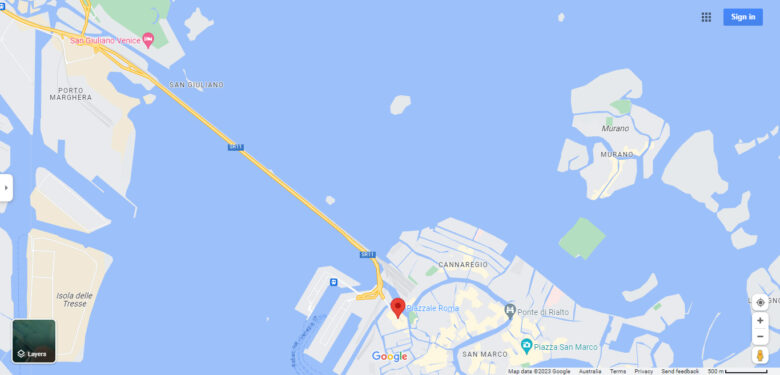
AIRPORT TRANSFERS
This section will go over the most efficient way to get from Marco Polo International Airport to the Venice islands. The method utilises only public transport and is the cheapest and easiest way and gets you to Piazzale Roma, the main transport hub in Venice Islands. It will also go over why the Alilaguna boat is not recommended. Click here to skip to the public transport transfers method.
Note: It is important to specify Marco Polo Airport (or Treviso, if you are travelling to/from there) specifically when using a way-finding service. A search on Google maps may show that the trip from “Venice airport” to Venice the islands take over an hour, sometimes an hour 45 minutes or even longer, so you may be tempted to take the blue Alilaguna boat (which will be discussed later). However, remember that there are two airports in Venice and the travel time from the two of them to the islands vary significantly, so be sure to know exactly which airport you need to look for when looking at any maps or travel time estimates. Unless there are traffic issues, trip estimates that take over an hour, hour and 45 minutes, are from Treviso Airport (since it is technically still “Venice” Airport) but is more along the lines of 30-45 minutes when travelling from Marco Polo airport, even by public transport.
Why I don't recommend the Alilaguna boat
Many guides or sources will tell you that the only way to get to Venice islands is by an expensive water taxi or that the trip is very long. While the water taxis are expensive, the rest of that statement is not necessarily true.
The blue Alilaguna boat is a private shuttle service and not included in the Venetian public transport passes. If you have budget to stick to, you can skip the Alilaguna boat and use only public transport and you will not miss out on much nor use too much extra time. This is because even though the Alilaguna boat leaves from the airport and takes you “directly” to the Venice islands, actually, so does the bus. The Alilaguna boat takes 37 minutes to drop you off in the northeastern side of the Venice island at either Murano, which is an island that is not even in the main historical center of Venice island, or Fondamente Nove, the ferry stop on the northeastern side of the main Venice island, whereas the public transport bus drops you off in the center of the island on the northwestern side (Piazzale Roma) and takes roughly the same amount of time, costs less than the Alilaguna boat, both are already in the islands and most likely both would require you to do further onwards travel anyway.
Why use public transport for transfers from Marco Polo International Airport:
The cheapest and easiest way and to get to Venice Islands sees you dropped off by bus in Piazzale Roma, the main transport hub in Venice Islands. It is located roughly in the center of the islands but on the northwestern side.
Note that this method requires changing transport methods from a public transport bus (boarded directly outside Marco Polo International Airport), to a ferry/vaporetto if you require further onwards travel to say, your hotel (I say ‘if’ but you almost certainly will), and requires separate tickets. The cost of the ferry can vary depending on whether you get a single ticket, or if you are staying in Venice for longer, an unlimited ticket with a timed validity of 24, 48, or 72 hours.
The bus alone gets you to Piazzale Roma and the separate ferry ticket is required for onwards travel within Venice Islands (or if you are happy to walk the convoluted paths, on foot). You will need a ferry ticket for onwards travel as the Venice islands have many winding streets and canals and you will be spending most of your time walking long distances rather than sightseeing if you choose to walk instead of taking the ferry.
For example, San Marco Square is almost 2.5km from Piazzale Roma by foot, and this does not include the distances to or from any other place in Venice, so unless you are okay with spending most of your time walking very long distances, you should get a ferry ticket too. Besides, Murano and Burano Islands are a must visit when in Venice and the only way to get there is by water (ferry, unless you want to pay for a private water taxi).
How to get from Marco Polo Airport to Venice islands by public transport:
Take the Aerobus bus number 5, this is a Venice public transport ACTV service and is known as the Venice Airport shuttle bus. The bus stop is very close outside the airport, mere metres away from the exit. This bus takes you all the way to Piazzale Roma in the Venice Islands. At the time of visiting, a one way ticket costs just €8 per person, whereas a one way ticket from Marco Polo Airport to Piazzale Roma by the Alilaguna boat costs €15 and takes approximately the same time (albeit to different ends of the island). Since the Alilaguna shuttle boat is not included in the timed ferry ticket and you will need to buy that separately anyway, it is cheaper to pay €8 than €15 to get to Venice Island.
There are ticket machines inside the arrivals terminal right near the baggage carousel but unless you are completely sure of which ticket you want, you should just buy them from the manned desks just outside the doors in the arrivals terminal.
How much does the Aerobus Venice airport shuttle bus cost?
When buying the Aerobus ticket: it costs 8€ on its own or 7€ when purchased at the same time as the hourly ACTV public transport ticket (below).
Where to get off the bus in Venice:
Get off at the last stop of Piazzale Roma after crossing the Ponte della Liberta bridge. You can’t miss the stop as it is the last stop, everyone who stays on the bus after the bus gets on the bridge is going there, and the driver will announce it (in Italian which is pronounced pretty much the way it is spelt).
The bus arrives in the main square in Piazzale Roma right by the water where the ferries are just a few steps away. The trip takes between 30-40 minutes.
Ferry/Vaporreto (water bus)
Where and how to buy Venice (Venezia) ferry/Vaporetto (water bus) tickets
Tickets for the ferry can be purchased at ticket booths outside each ferry dock within Venice with notes, coins, and card, or at the airport from a ticket vending machine or from a manned desk after you collect your bags and exit the bag collection hall.
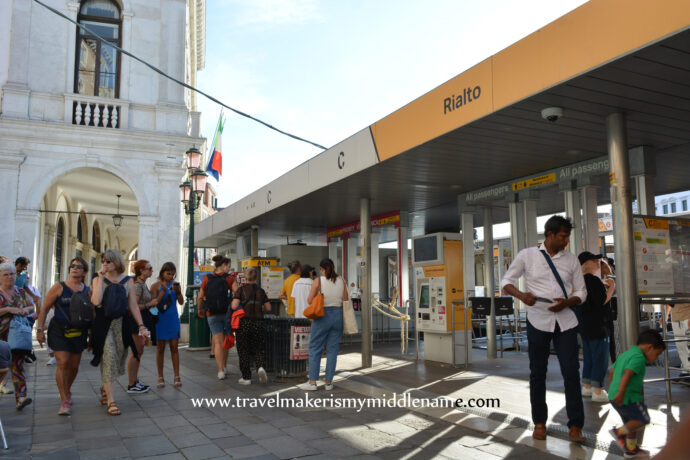
Ferry ticket prices and information: See the official website for prices of the tickets: https://actv.avmspa.it/en/content/venice-urban-services-0
Tip: If making the purchase at least 30 days beforehand, you can save a few euros (the exact amount varies) by buying the Venezia Unica card on its official website: https://www.veneziaunica.it/en/e-commerce/services, however you then need to collect the physical ticket at one of their collection points which can be found on their official website: https://www.veneziaunica.it/en/content/purchase
You should download the official Venice ferry/vaporetto app to see the timetable for travelling between stops in the island. The official app is called “AVM Venezia Official App” and is available on both Android and Apple app stores.
What to do in Venice
Venice does not have to be an expensive destination. Many, if not all, of the main attractions, are free in some way, so if you are on a budget, you really only need to pay for food, transport and accommodation.
Venice is known for its old-world charm and traditional European architecture. Simply taking a stroll in the streets enables you to take in the authentic views of the canals, the old buildings, and the gondolas. A walk in the neighbourhoods away from the touristy areas give you a view of how the locals live.
Check out my list of 13 things to do in Venice, or see below for a brief overview.
Some famous Venetian attractions and must visit locations in Venice include:
The Rialto Bridge

Cost: Free
The largest stone bridge in the Venice island. There is a ferry stop nearby with the same name so is not difficult to find. Restaurants have outdoor seating immediately at the foot of the bridge so during the day and especially in peak seasons, can get very busy.
San Marco Square, the Bell Tower and the Basilica
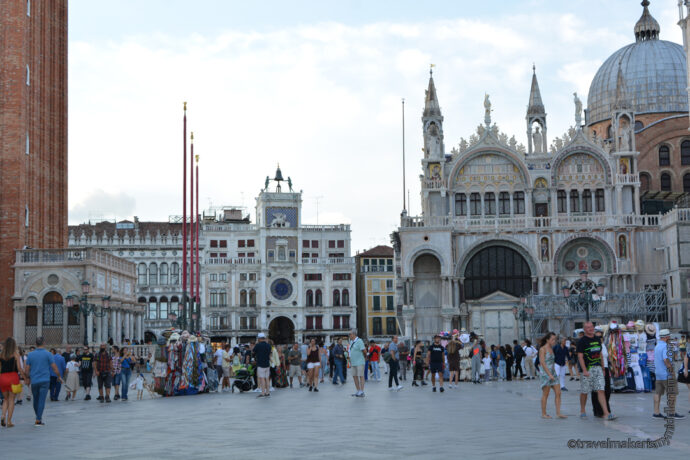
Cost: Free/Paid
At the time of my visit in 2022, the Basilica was closed for restoration, like almost everywhere else I went in Europe. However, the San Marco (St Mark’s) Square is an open space where you can admire the outside of the Basilica and the Bell Tower, for free. When the Basilica is open and if you wish to climb the Bell Tower, a separate entry fee applies.
Murano and Burano islands

Cost: Free entry (ferry ticket extra)
Murano and Burano islands are two small islands further north of the main Venice islands and are both well known for their glass handicrafts and coloured houses. They are definitely worth a visit if you are in Venice. At the time of writing, there are no separate charges and one only needs to take a 19 minute ferry (vaporetto) there.
Venice entry fees 2024
On April 25th 2024, Venice introduced a 29-day testing period of charging entry fees to the historical town of Venice to day visitors who do not stay overnight.
During the 29-day trial period, day visitors over 14 years old will be charged 5€ each for each day they visit. Visitors will be charged on the following 29 days in 2024 between 8:30am to 4pm daily:
April: 25, 26, 27, 28, 29, 30
May: 1, 2, 3, 4, 5, 11, 12, 18, 19, 25, 26
June: 8, 9, 15, 16, 22, 23, 29, 30
July: 6, 7, 13, 14
Day visitors entering outside this period will not be charged. For details, be sure to read this article.
Related Posts
-
13 Free and paid things to do in Venice, Italy
A non-exhaustive list of 13 free and paid things to do in Venice, Italy (plus…
-
Why you need to visit Venice NOW Summer 2023
Why you should visit Venice before it is too late (and no, it has nothing…
-
Cinque Terre, Italy: A practical guide for first-time visitors - where to stay, how to get there and what to expect
Cinque Terre is a group of five small coastal towns in the Liguria region on…

